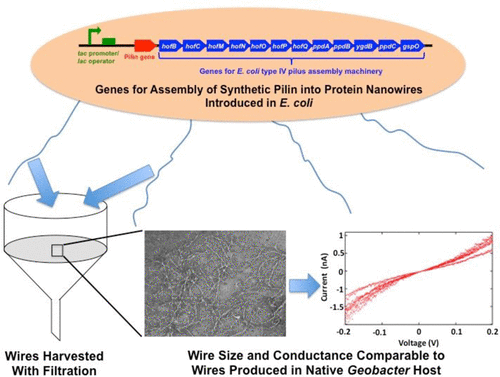当前位置:
X-MOL 学术
›
ACS Synth. Biol.
›
论文详情
Our official English website, www.x-mol.net, welcomes your
feedback! (Note: you will need to create a separate account there.)
An Escherichia coli Chassis for Production of Electrically Conductive Protein Nanowires.
ACS Synthetic Biology ( IF 3.7 ) Pub Date : 2020-03-11 , DOI: 10.1021/acssynbio.9b00506 Toshiyuki Ueki 1, 2 , David J F Walker 1, 2 , Trevor L Woodard 1 , Kelly P Nevin 1 , Stephen S Nonnenmann 2, 3 , Derek R Lovley 1, 2
ACS Synthetic Biology ( IF 3.7 ) Pub Date : 2020-03-11 , DOI: 10.1021/acssynbio.9b00506 Toshiyuki Ueki 1, 2 , David J F Walker 1, 2 , Trevor L Woodard 1 , Kelly P Nevin 1 , Stephen S Nonnenmann 2, 3 , Derek R Lovley 1, 2
Affiliation

|
Geobacter sulfurreducens' pilin-based electrically conductive protein nanowires (e-PNs) are a revolutionary electronic material. They offer novel options for electronic sensing applications and have the remarkable ability to harvest electrical energy from atmospheric humidity. However, technical constraints limit mass cultivation and genetic manipulation of G. sulfurreducens. Therefore, we designed a strain of Escherichia coli to express e-PNs by introducing a plasmid that contained an inducible operon with E. coli genes for type IV pili biogenesis machinery and a synthetic gene designed to yield a peptide monomer that could be assembled into e-PNs. The e-PNs expressed in E. coli and harvested with a simple filtration method had the same diameter (3 nm) and conductance as e-PNs expressed in G. sulfurreducens. These results, coupled with the robustness of E. coli for mass cultivation and the extensive E. coli toolbox for genetic manipulation, greatly expand the opportunities for large-scale fabrication of novel e-PNs.
中文翻译:

用于生产导电蛋白纳米线的大肠杆菌底盘。
减少氧化细菌的地基菌毛的导电蛋白纳米线(e-PNs)是一种革命性的电子材料。它们为电子传感应用提供了新颖的选择,并具有从大气湿度中收集电能的出色能力。但是,技术上的限制限制了硫还原菌的大规模培养和遗传操作。因此,我们设计了一种大肠杆菌菌株,通过引入一个质粒来表达e-PNs,该质粒包含具有可诱导操纵子的大肠杆菌基因(用于IV型菌毛生物发生机制)和一个合成基因,该合成基因被设计为可组装成e -PNs。在大肠杆菌中表达并通过简单过滤方法收获的e-PNs的直径(3 nm)和电导率与在G.硫还原菌中表达的e-PNs相同。这些结果,
更新日期:2020-03-12
中文翻译:

用于生产导电蛋白纳米线的大肠杆菌底盘。
减少氧化细菌的地基菌毛的导电蛋白纳米线(e-PNs)是一种革命性的电子材料。它们为电子传感应用提供了新颖的选择,并具有从大气湿度中收集电能的出色能力。但是,技术上的限制限制了硫还原菌的大规模培养和遗传操作。因此,我们设计了一种大肠杆菌菌株,通过引入一个质粒来表达e-PNs,该质粒包含具有可诱导操纵子的大肠杆菌基因(用于IV型菌毛生物发生机制)和一个合成基因,该合成基因被设计为可组装成e -PNs。在大肠杆菌中表达并通过简单过滤方法收获的e-PNs的直径(3 nm)和电导率与在G.硫还原菌中表达的e-PNs相同。这些结果,











































 京公网安备 11010802027423号
京公网安备 11010802027423号